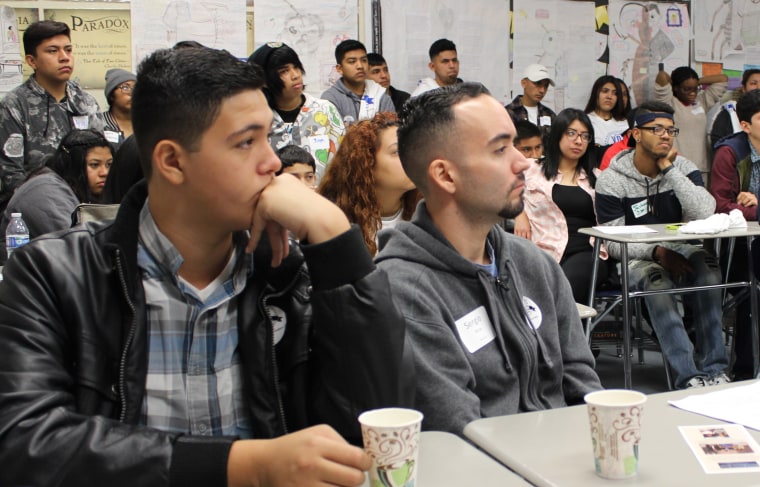A record number of U.S.-born Latinos will be turning 18 by Election Day and are expected to have a significant impact at the polls in November, says a report examining Hispanic demographic trends and consumer behavior within the community.
The report, “From the Ballot Box to the Grocery Store: A 2016 Perspective on Growing Hispanic Influence in America,” from the Nielsen marketing research firm states that 6 million young Latinos will have become eligible to vote between the presidential election in 2008 and this year's election.
Since the last presidential election in 2012, 3.4 million Latinos are expected to have turned 18 by this November and represent 12 percent of the total Latino voting population — larger than any other group of the same age. Non-Hispanic young white voters and Asian Americans in the same age group are just 6 percent of their respective population’s eligible voters, while African American 18-year-olds are 9 percent of the black voting population.
Additionally, the analysis released Aug. 23, reported that 65 percent of all Latino eligible voters are under the age of 44. The coming of age so many Latinos may be an element in reports of increases in Latino voter registrations in parts of the country.
Spikes in registration of Latinos have been reported in Arizona, Florida, Nevada and Texas, as well as in Georgia and North Carolina, where the increase in Hispanic voter registration has been larger in 2016 than the increase for other voting segments. The center stage that immigration has taken in this year’s election also is believed to be playing a role.
Despite a recent study that showed a slowdown in the growth and dispersion of the Latino population, naturalization applications from those already here have increased, and Nielsen predicts a “more robust” voter turnout among Latinos compared to other years.
As the population has increased, the number of Latinos who vote has steadily increased. The National Association of Latino Elected and Appointed Officials has projected 13 million Latinos will vote in 2016. But the share of Latinos who showed up at the polls fell to 27 percent in 2014, down from 31.2 percent in 2010, so the share of the Hispanic population isn't growing as the numbers of eligible Hispanic voters increase.
RELATED: For 2016, Almost Half the Latino Electorate Will Be Millennials
“The community is a young and growing voter base,” says Stacie de Armas, vice president for Strategic Initiatives & Consumer Engagement at Nielsen. “And while 12 percent of the electorate may not sound like much, it is incredibly valuable because it is spread out all over the country, including key swing states. It’s a critical part of the electorate.”
A majority of Latino voters — 55 percent — surveyed in a Harris poll said they plan on voting Democratic in November, while 14 percent identify as Republican, and 30 percent as independents.
The study also found that “ambicultural” Latinos comprise an increasing portion of the country’s Latino population. Ambicultural Hispanics are identified as those who consider themselves “entirely American and entirely Latino” and are able to move within both cultures with ease. “They are completely flexible in both languages and completely flexible in both cultures and are able to cross both cultures so fluently,” de Armas told NBC News. “It’s an incredible opportunity.”
And while the Latino population has a increasing proficiency in English, 55 percent of Latinos are bilingual. Spanish is still spoken by many of those who identify themselves as English-dominant speakers, and many consider advertising and other messaging in Spanish to be very relevant.
RELATED: Young Voters Show the Potential, Uncertainty of Latino Millennial Vote
Researchers reported that Latinas have made the most gains in educational advancement, outpacing African Americans and non-Hispanic whites for college enrollment.
“These increases in education level are helping to drive many positive economic results, including rising household income,” the study states. The Latino community also leads the nation in buying power at $1.3 trillion, and the percent of Latinos with a household income greater than $50,000 has risen to 43 percent, up from 30 percent in 2000.
Nielsen also looked at social media usage among the Latino community and found that both younger and older Latinos and Latinas report using social media in high numbers.
“We’re a very connected community culturally, and that then lends itself to being socially and digitally connected as well,” said de Armas. “That’s how we communicated with our families, that’s how we get information from home. Social media is a conduit back to our culture and our community.”
The Nielsen study used data from various sources, including: a Harris Poll conducted online in English between January 13-18 of this year that surveyed 2,193 adults nationwide, including 146 Hispanics and a Harris Poll conducted online in English between March 16-31 among 2,236 adults, which included 510 Hispanics who were interviewed in Spanish and English to represent Spanish-dominant, English-dominant, and bilingual households.
The report also included data gathered in the Nielsen Scarborough Hispanic Multi-Market research of both English and Spanish-speaking adults in the top 36 Hispanic Demographic Market Areas (DMAs), and the surveys of people who carry the Personal People Meter (PPM), a device that records their programming preferences.
